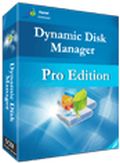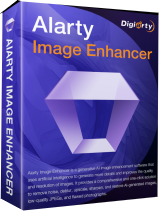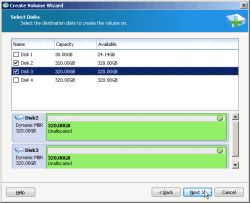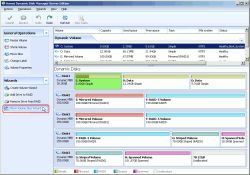Chaque jour, nous vous offrons des logiciels sous licence GRATUITS que vous devriez autrement payer!

Giveaway of the day — AOMEI Dynamic Disk Manager Pro
L'offre gratuite du jour pour AOMEI Dynamic Disk Manager Pro était valable le 18 mars 2013!
AOMEI Dynamic Disk Manager Pro Edition propose des fonctionnalités basiques ou avancées permettant de créer soit un nouveau volume, soit d'étendre le volume existant, mais également de résoudre les problèmes de manque d'espace sur le disque C, de déplacer les tranches de volume d'un disque à un autre, ou bien encore de convertir un disque dynamique en disque basique, et inversement. Toutes les opérations sont destinées à rendre votre ordinateur plus performant !
Fonctionnalités clés :
- Gestion de volume dynamique : création, suppression, redimensionnement, diminution, extension des disques dynamiques ; modification de la lettre de lecteur et de l'étiquette de volume pour une reconnaissance simplifiée.
- Converteur de disque : disque dynamique en disque basique, et vice versa ; disque GPT en MBR ; disque MBR en GPT ; disque GPT en MBR destiné à une installation sur système d'exploitation Windows ; initialisation du disque au format MBR ou GPT.
- Assistant étape par étape.
Configuration minimale:
Windows 2000 Professional, XP Professional (x32/x64), Vista Business/ Enterprise/ Ultimate (x32/x64), 7 and 8 Professional/ Enterprise/ Ultimate (x32/x64), 7 SP1, Server 2012
Éditeur:
Aomei TechnologyPage web:
http://www.dynamic-disk.com/ddm/aomei-dynamic-disk-manager-pro.htmlTaille du fichier:
22.5 MB
Prix:
$39.00
Commentaires sur AOMEI Dynamic Disk Manager Pro
Please add a comment explaining the reason behind your vote.
Looks like an excellent Partition manager tool but only for very advanced and demanding users who know how to handle a HD properly and what's the main difference between dynamic and basic disks.
In fact with this software users can create/delete/format all types of dynamic volume with no hassle, as well as resize, shrink and extend the dynamic system volume in order to solve the notorious "low disk space on C drive" issue with ease and free up some unallocated space for further usage.
Now the question is: how can I tell which type of disk I have (Basic or Dynamic)? And why should I convert a basic HD to a dynamic one??
Well by default Windows uses Basic disks, so almost everybody should have BASIC disks running in their system.
But to settle things once & for all....
Right click on Computer ==> Manage ==> Disk Management and under the Disk you will see the current configuration (Basic or Dynamic).
This GAOTD can also convert a BASIC HD to a DYNAMIC one with a single mouse click, but you can manually do that for FREE by simply right clicking on the disk icon in the DISK MANAGEMENT section (the system will prompt you for the basic to dynamic and also from dynamic to basic).
As far as the second question is concerned, just read this excellent article describing the main differences between the 2 type of disks:
http://www.dynamic-disk.com/difference-between-basic-and-dynamic-disk.html
Generally speaking, the main advantage of having DYNAMIC DISKS running in your system is that Vista/Windows7 can create/expand/contract partitions more easily & effectively, but since there are nowadays so many 3d party tools which can do the same things for FREE on basic partitions, I can't see why one should convert a basic disk to a dynamic one just because he/she doesn't want to install a third party tool in their machine.
Another advantage is that Dynamic Disks can create an UNLIMITED number of partitions, as well as handle partitions of over 2TB in size.
But hey, how many people out there need more than 3 partitions in their machine?? If you need 2TB of storage space (to store what?? The Pentagon & Nasa database?? LOL!!) you can use an external HD for that with no hassle.
Besides that, such a conversion can get you into troubles: for instance, DON'T even try to convert a BASIC disk, containing an installed operating system, to a DYNAMIC one, because if you do that your OS will not be able to boot or start anymore.
So, all things considered, unlike you are an advanced and very demanding geek, my suggestion is to stick with basic partitions, as I do, since they can be managed more easily by using FREE third party partition manager tools like PARTED MAGIC and/or PARTITION WIZARD, for instance:
* Parted Magic (==> My Personal First Choice)
GParted + Partimage + TestDisk + Truecrypt + Clonezilla + G4L + SuperGrubDisk + ddrescue etc...
Key Features:
Format internal and external hard drives
Move, copy, create, delete, expand & shrink hard drive partitions
Clone your hard drive, to create a full backup
Test hard drives for impending failure
Test memory for bad sectors
Benchmark your computer for a performance rating
Securely erase your entire hard drive, wiping it clean from all data
Gives access to non-booting systems allowing you to rescue important data
http://partedmagic.com/doku.php
Tutorial GParted:
http://gparted.sourceforge.net/help.php
It runs from a CD, so no install is required; however, if you wish to, you can also create a bootable Live (Linux-based) USB drive for it, thus without burning any CD, using the excellent freeware "UNetbootin":
http://partedmagic.com/doku.php?id=creating_the_liveusb
* Partition Wizard
Key Features:
Rebuild MBR
Partition Recovery
Move/Resize Partition
Split Partition
Extend Partition
Change Cluster Size
Copy Partition
Create, Delete & Format Partition
Convert File System
Hide/Unhide Partition
Explore Partition and much more.
http://www.partitionwizard.com/free-partition-manager.html
Bootable CD/DVD & Bootable Version even for 64 bit OS:
http://www.partitionwizard.com/download.html
Enjoy!!!
Ciao
Giovanni
I was looking forward to testing this until I installed and opened it. It detects all of my partitions but one (350GB NTFS) which it claims is unallocated space. I nearly had a heart attack because that's my media partition! After confirming that the partition is indeed there and working as it should be, I don't trust this program enough to let it make any changes to any of my drives. YMMV.
I swear Giovanni, if it weren't for you, and your information, I'd have Fracked my machine so many times. Thanks for the insight. I always read your comments, they're easy to understand. Thanx Bro.
Uncheck "Check for update at startup" in the Help menu !
Otherwise the free period might end because of an automatic update.
MAKE SURE YOU HAVE THE RIGHT REQUIREMENTS...
Windows 2000 Professional, XP Professional (x32/x64), Vista Business/ Enterprise/ Ultimate (x32/x64), 7 and 8 Professional/ Enterprise/ Ultimate (x32/x64), 7 SP1, Server 2012
This said... thanks for the giveaway....
P.S: Rule of thumb before doing any changes to your pc do backups ;-)





Heu... Je comprends pas bien...
La version Pro (offerte ici) est compatible Windows 2000 et Windows XP, mais elle ne permet pas de créer des "basic partitions" (comprendre MBR ?) ni de les modifier. Il faut créer un volume, puis le convertir en MBR pour que ça fonctionne sous 2000/XP ?
Save | Cancel